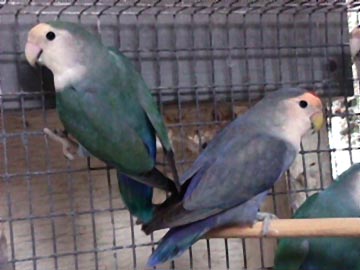Whiteface

The Whiteface factor is
found only in the blue series lovebirds. It presents itself as a
white forehead and bib, rather than the cantaloupe color of the Dutch
blue. (However, some whitefaces have a touch of flesh color on their
foreheads. The whiter the face, the more desirable.)
Below is the whitest whiteface
I've ever bred. His father is the WF pied on my pied page, and has a
paper-white face.

Below are two more whitefaces.

The one on the left is much
more blue. (He has a single violet factor, which enhances the blue
coloring.) The bird on the right is much greener.
You will also notice the
variation in the whiteness of their faces.

The bird on the left is a cobalt whiteface. (A
whiteface with a single dark factor.) The dark factor darkens the
body color as well as the color of the rump, which is a medium blue,
compared to the lighter blue of a bird with no dark
factor.
The bird on the right is a cobalt violet. He loses
some of his pizzazz in this photo. His colors are much more stunning
in real life.

And two whiteface slates. This is a whiteface with
two dark factors. It turns the body and rump both a charcoal gray.
The whiteface factor also removes the a large amount of the olive
green color you would see in a regular slate, as much of the pigment
that gives the green color has been removed.
The bird on the right is actually a WF slate pied,
as she has a single white flight feather on each wing.

This is a group of
whitefaces.
They vary some in color and in
the degree of the whiteness on their faces. Notice that the bird on
top is more blue (but he probably has a single violet factor as
well.)
The bird directly below
him is called a Seagreen.
This has a single whiteface
factor, rather than two required for a whiteface. It results in a
greenish bird with the cantaloupe forehead of a Dutch
blue.